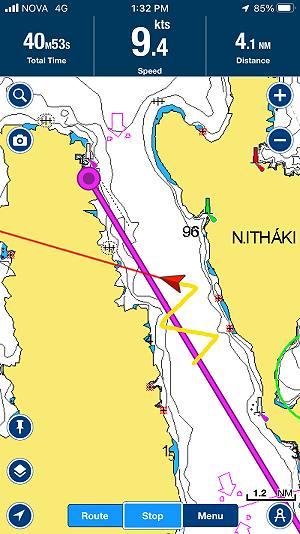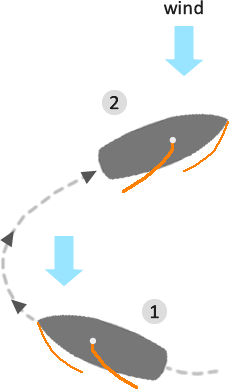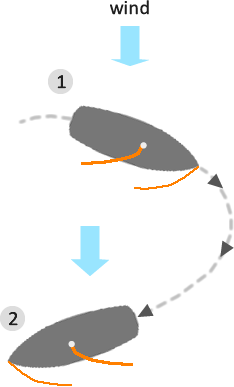Manoeuvres
From the wind's embrace to the dance with the waves, we dive into the heart of sailing techniques.
Whether you're a seasoned sailor or a novice, mastering these maneuvers is essential for navigating the seas.
Tacking
You'll use the Tacking maneuver frequently when sailing against the wind, requiring a series of zigzags against the wind direction to reach your destination.

The Tacking Process involves teamwork.
 See below for the steps to follow:
See below for the steps to follow:
1️⃣ One person sits beside each jib winch.
2️⃣ The helmsman calls "Ready about!" and, upon hearing "Ready" from the winch crew, shouts "Lee Ho!"
... and turns the wheel sharply towards the wind.
3️⃣ Simultaneously, the person on the leeward jib sheet quickly releases it from the winch.
4️⃣ The sails start to flap.
5️⃣ The person on the opposite side rapidly hauls the jib sheet, putting turns on the winch to tighten it.
The mainsail typically tacks itself, positioning on the other side as in the last tack.
It's crucial to be swift as sails could flap, leading to a state called 'in stays' where the boat is essentially stuck.
Escaping 'stays' can be tricky— try sailing backward or use the engine.
In strong winds, ropes may thrash about, posing potential danger.
Always be cautious!
Jybing
Jybing is turning the boat through the wind while sailing downwind.
 It's like making a quick and more intense turn compared to tacking.
It's like making a quick and more intense turn compared to tacking.
Safety is crucial, as a careless jybe can lead to injuries or even someone going overboard.
1️⃣ The helmsman manages the mainsail.
Firstly, they pull it towards the middle of the boat while turning the boat downwind.
2️⃣ Simultaneously, the person on the leeward jib sheet releases the jib (remembering to keep fingers away from the winch).
3️⃣ At this point, the sails will swiftly cross the deck, with a loud crash.
4️⃣ The person on the newly leeward jib sheet quickly tightens the sail, ensuring the jib sheet is entirely off the winch.
Failing to do this might result in a 'broach', tipping the boat to its side.
Any loose items will go flying, and your crewmates will be well aware of the chaos.
5️⃣ The helmsman eases the mainsheet swiftly to set the sail for the desired course.
If sailing straight downwind on a 'dead run,' there's a risk of an accidental gybe, known as a "Chinese gybe" or "crash gybe".
Everything goes flying, and recovery takes a few minutes.
The immediate action is to release the windward jib sheet, turn into the wind gently to stop the boat, gather everything, avoid any upset crew members, and resume sailing.

